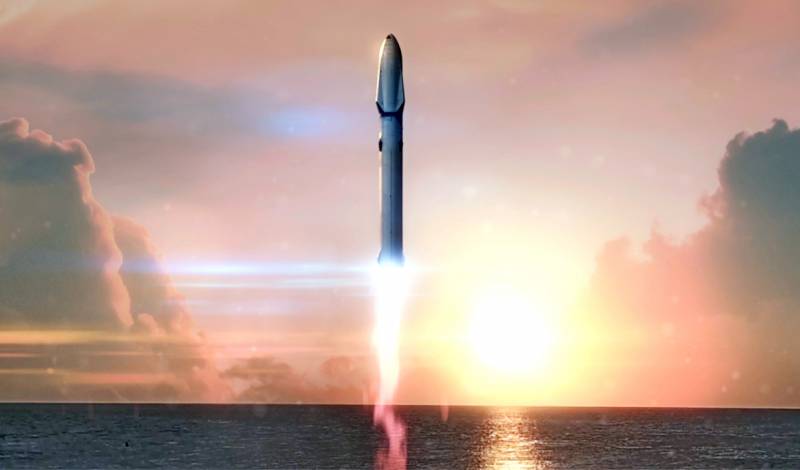China will overtake Russia on a super-rocket
The PRC government has approved the development of new classes of heavy launch vehicles, which Beijing expects to use in the future for its space missions. Already this year, China expects to demonstrate the operation of the Changzheng-9 engine, a new three-stage super-heavy launch vehicle.
The Chinese leadership expects that the rocket will be able to deliver manned missions to the moon. Actually, it is precisely for this purpose that the development of superheavy rockets is being carried out, with the help of which it will be possible to land expeditions on the Moon, Mars, and maybe on other planets.
At the Academy of Aerospace equipment and engine building (AART) of China, part of the structure of the China Space Corporation (CASC), report that these engines are capable of creating from 3500 to 4000 tons of thrust. If this is true, then “Changzheng-9” will become the most powerful of the existing Chinese missiles. Its power will be 6 times higher than the famous Changzheng-5 rocket. The new rocket will be able to bring up to 140 tons of payload into low Earth orbit and at least 50 tons of payload into lunar orbit.
So far, representatives of the Chinese space departments and the Academy of Aerospace Engineering and Engine Engineering have not revealed details about the full technical characteristics of the new rocket. But some information still got into the press. So, it is known that the diameter of the rocket will reach 10 meters. The first-stage engine, which runs on a kerosene-oxygen mixture, will be able to generate 480 tons of thrust. Engines of the second and third stages will operate on a special mixture of liquid hydrogen and liquid oxygen.
If China succeeds in presenting the engine this year, it will be another tangible success of the growing Chinese rocket science. So far, the only active super-heavy carrier rocket in the world is the Falcon Heavy, manufactured by SpaceX. Nearing the completion and refinement of the Space Launch System from NASA and BFR from SpaceX, as well as the Russian superheavy rocket KRK STK (space rocket complex superheavy class). But tests of the Russian superheavy rocket are scheduled only for 2028 (if there are no events that could interfere with development).
Thus, we see that China is making very serious successes in the field of rocket science and astronautics. The leadership of the country and the Communist Party pays great attention to the development of the space industry. For example, Beijing has adopted the Chang'e lunar research program, which involves sending a special research mission to the moon. Launched "Tiangong-1" - the first non-Soviet and non-American free-flying manned orbital station, which is capable of receiving unmanned and manned spacecraft "Shenzhou".
The Chinese leadership expects that the rocket will be able to deliver manned missions to the moon. Actually, it is precisely for this purpose that the development of superheavy rockets is being carried out, with the help of which it will be possible to land expeditions on the Moon, Mars, and maybe on other planets.
At the Academy of Aerospace equipment and engine building (AART) of China, part of the structure of the China Space Corporation (CASC), report that these engines are capable of creating from 3500 to 4000 tons of thrust. If this is true, then “Changzheng-9” will become the most powerful of the existing Chinese missiles. Its power will be 6 times higher than the famous Changzheng-5 rocket. The new rocket will be able to bring up to 140 tons of payload into low Earth orbit and at least 50 tons of payload into lunar orbit.
So far, representatives of the Chinese space departments and the Academy of Aerospace Engineering and Engine Engineering have not revealed details about the full technical characteristics of the new rocket. But some information still got into the press. So, it is known that the diameter of the rocket will reach 10 meters. The first-stage engine, which runs on a kerosene-oxygen mixture, will be able to generate 480 tons of thrust. Engines of the second and third stages will operate on a special mixture of liquid hydrogen and liquid oxygen.
If China succeeds in presenting the engine this year, it will be another tangible success of the growing Chinese rocket science. So far, the only active super-heavy carrier rocket in the world is the Falcon Heavy, manufactured by SpaceX. Nearing the completion and refinement of the Space Launch System from NASA and BFR from SpaceX, as well as the Russian superheavy rocket KRK STK (space rocket complex superheavy class). But tests of the Russian superheavy rocket are scheduled only for 2028 (if there are no events that could interfere with development).
Thus, we see that China is making very serious successes in the field of rocket science and astronautics. The leadership of the country and the Communist Party pays great attention to the development of the space industry. For example, Beijing has adopted the Chang'e lunar research program, which involves sending a special research mission to the moon. Launched "Tiangong-1" - the first non-Soviet and non-American free-flying manned orbital station, which is capable of receiving unmanned and manned spacecraft "Shenzhou".

Information